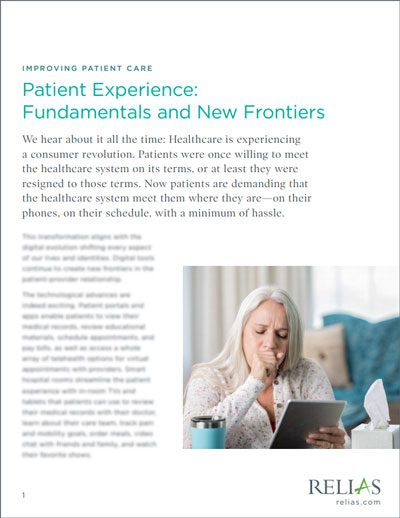The patient experience defined by the Beryl Institute is “the sum of all interactions, shaped by an organization’s culture, that influence patient perceptions across the continuum of care.” Exceeding patient expectations is not by chance, but is the result of conscious efforts made to create and sustain a culture of patient-centered care—including staff hiring, onboarding, development practices.
The Beryl Institute’s Experience Framework helps hospitals and health systems evaluate where they’re excelling or experiencing areas of opportunity for improving patient experience. The Experience Framework includes eight strategic lenses through which organizations can address experience improvement and excellence.
- Culture & Leadership: The foundation of any successful experience effort is set on who an organization is, its purpose and values, and how it is led.
- Infrastructure & Governance: Effective experience efforts require both the right structures and processes by which to operate and communicate and the formal guidance in place to ensure sustained strategic focus.
- Staff & Provider Engagement: Caring for those delivering and supporting the delivery of care and reaffirming a connection to meaning and purpose is fundamental to the successful realization of a positive experience.
- Policy & Measurement: Experience is driven and influenced by external factors and systemic and financial realities and requires accepted and understood metrics to effectively measure outcomes and drive action.
- Environment & Hospitality: The space in which a healthcare experience is delivered and the practices implemented to ensure a positive, comfortable and compassionate encounter must be part of every effort.
- Innovation & Technology: As a focus on experience expands, it requires new ways of thinking and doing and the technologies and tools to ensure efficiencies, expand capacities and extend boundaries of care.
- Patient, Family & Community Engagement: Central to any experience effort are the voices of, contributions from and partnerships with those receiving care and the community served.
- Quality & Clinical Excellence: Experience encompasses everything a person encounters, and the expectations they have for safe, quality, reliable, and effective care focused on positively impacting health and well-being.
3 Steps to Improve Patient Experience
 STEP 1: Hire the right person.
STEP 1: Hire the right person.
Poor hiring decisions impact turnover, which is disruptive to delivering safe, consistent, quality care. Does your organization hire based on subjective preferences or immediate need versus the best fit for the role and culture? How are you identifying and selecting top applicants?
Make better-informed choices by standardizing your pre-hire screening and compiling a more comprehensive candidate profile. Use assessments and role-specific, behavioral-based questions during the hiring process to provide additional insight to hiring managers.
Organizations focused on improving the patient experience of care should ensure their hiring process evaluates and benchmarks the following:
- Clinical knowledge: Does the candidate have the technical knowledge to complete the required job tasks?
- Situational awareness: How would this candidate interact with others: i.e. physicians, patients, and families?
- Behavioral traits: Does this candidate have the right personality and sensibilities to work in this unit/organization?
 STEP 2: Get serious about onboarding.
STEP 2: Get serious about onboarding.
Onboarding is critical to staff’s future productivity and retention. However, most hospitals have traditional, one-size-fits-all onboarding programs, that are less specific to the unique learning needs of a new hire or transfer. This can lead to decreased engagement, inefficient use of resources, and/or high variation of knowledge and skills.
It becomes essential to focus onboarding education in a relevant, engaging way to prepare an organization’s workforce for safe, independent practice. Personalized learning plans based on identified knowledge and skill gaps will maximize an onboarding program’s efficiency and effectiveness. Benefits of personalized onboarding, include:
- Increased staff engagement and satisfaction by respecting existing knowledge/skills
- Saved time and resources by focusing education in areas of most needed improvement
- Prepared, competent new hires or transfers
 STEP 3: Invest in lifelong learning.
STEP 3: Invest in lifelong learning.
The patient experience is the result of combined interactions and care from various hospital staff, making consistent and quality care crucial to the process. The healthcare landscape is changing and it becomes even more vital that nurses remain engaged and committed in lifelong learning.
Healthcare organizations are experiencing higher levels of patient acuity with an increase in complexity of patients. This encourages healthcare professionals to better understand the populations they serve to promote optimal outcomes. Lifelong learning is an important strategy to keeping staff engaged and enthusiastic and to remind them of their impact in providing safe and effective care.
It’s essential for healthcare organizations to provide education on current evidence-based practices and to invest in continuing development and growth. Providing growth opportunities specific to identified professional learning needs could include:
- Focused clinical topics: opioids, behavioral health, readmissions, sepsis
- Leadership skills: change management, performance feedback, communication, teamwork
Final Takeaways
Building a workforce focused on creating and sustaining a culture of patient-centered care is essential to healthcare excellence. Selecting and placing the right people on your teams, providing an individualized onboarding experience, and investing in professional growth and lifelong learning are key components to this process. Exceeding patient expectations is the result of conscious efforts made to create and sustain a culture of patient-centered care.
Learn more about how Relias helps hire, onboard, and continuously develop your staff.

Patient Experience: Fundamentals and New Frontiers
Healthcare is experiencing a consumer revolution. Patients are demanding that the healthcare system meet them where they are—on their phones, on their schedule, with a minimum of hassle. This white paper to explore some of the ways innovation can strengthen patient experience.
Download the white paper →






 STEP 1: Hire the right person.
STEP 1: Hire the right person. STEP 2: Get serious about onboarding.
STEP 2: Get serious about onboarding. STEP 3: Invest in lifelong learning.
STEP 3: Invest in lifelong learning.